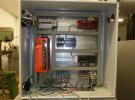I'm working on a project that needs to read the dutycycle of an input. I have no problem using the control panel and it works fine. My problem is that I don't read/write in C.
Can you show me how to do this using VB.net? Sorry, I know this is a reoccuring request, but many of us don't write C, only VB.
Thank you.


.png%3Fitok=PHGBxf6M)


.jpg%3Fitok=B1YcuDFK)
.png%3Fitok=Ybt-OlgU)
Take a look at the .NET examples for VB .NET examples:
https://labjack.com/support/software/examples/ud/dotnet
There is a U6_TIMERCOUNTER example to help get you started.
Specific to duty cycle inputs, use timer mode 4 which is .NET constant LJUD.TIMERMODE.DUTYCYCLE. After configuration use the IO constant LJUD.IO.GET_TIMER to read the timer value containing duty cycle information. Similar to this which is reading the timer value from timer 0 configured for duty cycle (duty cycle information returned by reference through dblValue):
LJUD.eGet(u6.ljhandle, LJUD.IO.GET_TIMER, 0, dblValue, dummyDoubleArray)
The duty cycle input timer mode is further documented here, discussing configuration and what the read timer value is:
https://labjack.com/support/datasheets/u3/hardware-description/timers-co...
Thanks, I'll give them a look. The problem I was having was that the examples were all written in c, not vb.
We wrote this function:
Private Function DutyCycleCheck(channelNum As LJUD.CHANNEL, frequency As Double) As Double
Dim dutyCyle As Double
Dim labjack As U6 = New U6(CONNECTION.USB, "0", True)
Dim MSW As Double
Dim LSW As Double
Dim factor As Double = 10 ^ 6
Dim AverageDutyCycle As Double
AddRequest(labjack.ljhandle, IO.PUT_TIMER_MODE, channelNum, TIMERMODE.DUTYCYCLE, 0, 0) ' sets the timer mode on the channel to look at duty cycle
AddRequest(labjack.ljhandle, IO.PUT_TIMER_VALUE, channelNum, 1, 0, 0) 'Resets Timer to 0
GoOne(labjack.ljhandle) 'execute request
Threading.Thread.Sleep(500)
eGet(labjack.ljhandle, IO.GET_TIMER, channelNum, dutyCyle, 0) 'Gets the duty cycle from the timer channel and stores it in the dutyCycle variable
LSW = dutyCyle Mod 2 ^ 16 'least significant word from first 2 bytes
MSW = dutyCyle / (2 ^ 16) 'most significant word for the last 2 bytes
LSW = LSW / factor
MSW = MSW / factor
LSW = LSW / (1 / frequency)
MSW = MSW / (1 / frequency)
AverageDutyCycle = (LSW + MSW) / 2.0
Return AverageDutyCycle * 100.0 'multiply by 100%
End Function
Unfortunately, when I use this I get an answer even if the target source is not connected to the Labjack. Can you see an error?
You need to enable the timer with a NUMBER_TIMERS_ENABLED before you can configure the timer and read from it. The U6_TimerCounter example demonstrates the standard way to configure the timers' clock, number of timers enabled, counters if needed, timer modes and read the current timer value.
Also, there is general UD driver documentation on timer and counter usage:
https://labjack.com/support/datasheets/u6/high-level-driver/example-pseu...
Note that constant prefixes in the docs. are this in .NET:
LJ_io -> LJUD.IO.
LJ_tm -> LJUD.TIMERMODE.
LJ_ch -> LJUD.CHANNEL.
LJ_tc -> LJUD.TIMERCLOCKS.
If you run into further problems, what error are you getting? You can use exception handling on the code to get the error.
Thanks! No more crash. BTW, how to I handle getting four returns/dutycycles. I'm only working with one right now. How does the LJUD return from four?
Tim
Never mind, that was stupid. Inc the eGet lines with each channel and use a diff holder for the data.